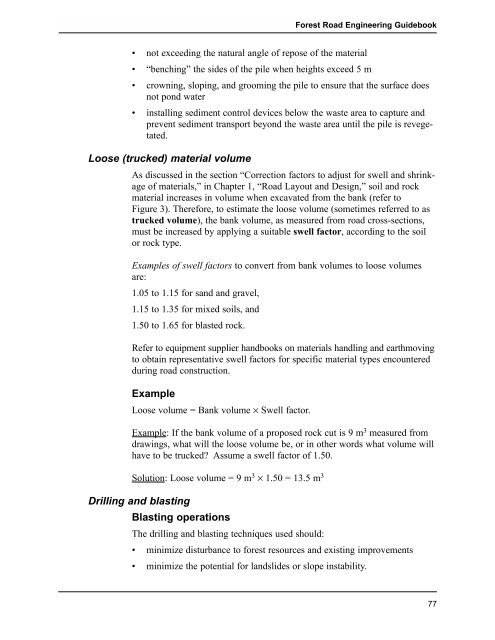Forest Road Engineering Guidebook - Ministry of Forests
Forest Road Engineering Guidebook - Ministry of Forests
Forest Road Engineering Guidebook - Ministry of Forests
Create successful ePaper yourself
Turn your PDF publications into a flip-book with our unique Google optimized e-Paper software.
• not exceeding the natural angle <strong>of</strong> repose <strong>of</strong> the material<br />
• “benching” the sides <strong>of</strong> the pile when heights exceed 5 m<br />
• crowning, sloping, and grooming the pile to ensure that the surface does<br />
not pond water<br />
• installing sediment control devices below the waste area to capture and<br />
prevent sediment transport beyond the waste area until the pile is revegetated.<br />
Loose (trucked) material volume<br />
As discussed in the section “Correction factors to adjust for swell and shrinkage<br />
<strong>of</strong> materials,” in Chapter 1, “<strong>Road</strong> Layout and Design,” soil and rock<br />
material increases in volume when excavated from the bank (refer to<br />
Figure 3). Therefore, to estimate the loose volume (sometimes referred to as<br />
trucked volume), the bank volume, as measured from road cross-sections,<br />
must be increased by applying a suitable swell factor, according to the soil<br />
or rock type.<br />
Examples <strong>of</strong> swell factors to convert from bank volumes to loose volumes<br />
are:<br />
1.05 to 1.15 for sand and gravel,<br />
1.15 to 1.35 for mixed soils, and<br />
1.50 to 1.65 for blasted rock.<br />
Refer to equipment supplier handbooks on materials handling and earthmoving<br />
to obtain representative swell factors for specific material types encountered<br />
during road construction.<br />
Example<br />
Loose volume = Bank volume × Swell factor.<br />
Example: If the bank volume <strong>of</strong> a proposed rock cut is 9 m 3 measured from<br />
drawings, what will the loose volume be, or in other words what volume will<br />
have to be trucked? Assume a swell factor <strong>of</strong> 1.50.<br />
Solution: Loose volume = 9 m 3 × 1.50 = 13.5 m 3<br />
<strong>Forest</strong> <strong>Road</strong> <strong>Engineering</strong> <strong>Guidebook</strong><br />
Drilling and blasting<br />
Blasting operations<br />
The drilling and blasting techniques used should:<br />
• minimize disturbance to forest resources and existing improvements<br />
• minimize the potential for landslides or slope instability.<br />
77

















